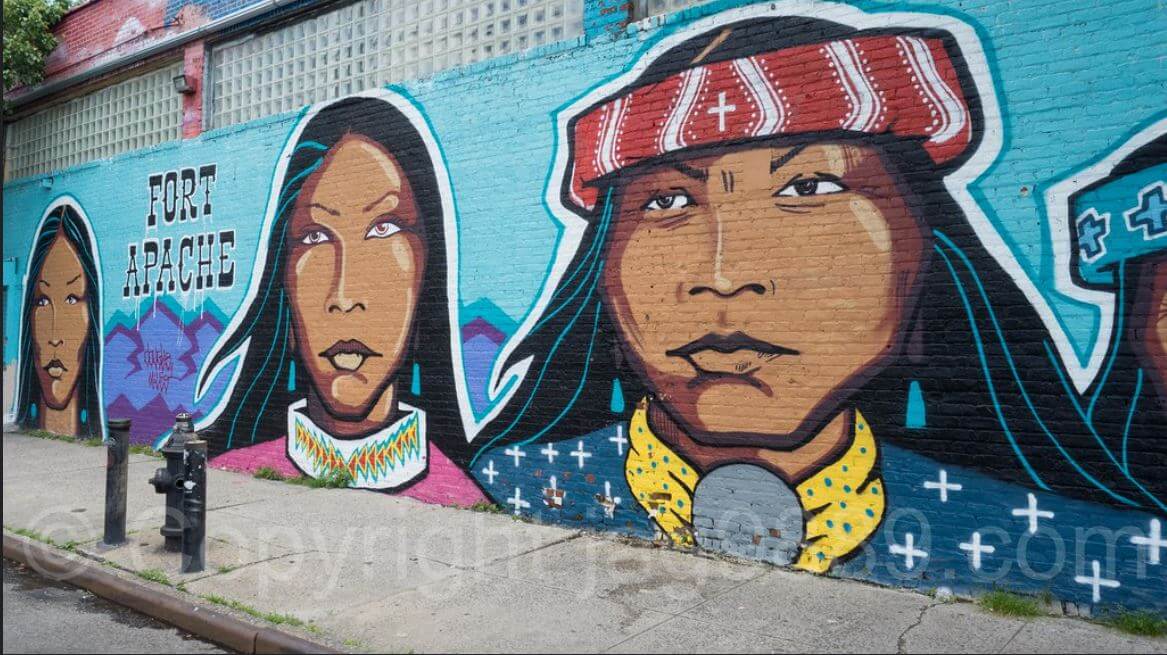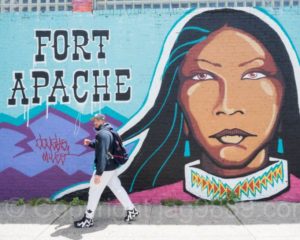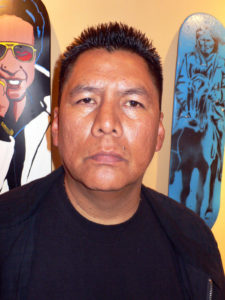I was introduced to Douglas Miles by the Brooklyn born Hip-Hop photographer, Ernie Paniccioli. Ernie’s revolutionary photography humanized and celebrated Hip-Hop performers. As the Bronx born rapper KRS1 said, “while others chose to photograph only those rappers, they thought it could make them a fast buck, Paniccioli photographed the rise of the greatest in city movement of the last 27 years of the 20th Century.”
Having written about Ernie’s career and his Indigenous (Cree) background, he suggested that I speak to Douglas.
Douglas Miles is a San Carlos Apache Akimel O’odham painter, printmaker and photographer, who founded Apache Skateboards and Apache Skate Team. In 2019, Miles and Apache Skateboards were featured in the documentary The Mystery of Now. In the film, Miles shares the socio-political context around the history that led to life on the San Carlos Apache reservation. The Mystery of Now was featured in National Geographic’s short film showcase.
I spoke to Doug at the beginning of August 2021.
“How do you know Ernie?”
“I met Ernie at the Brooklyn Museum of Music (BAM). Ernie is a super cool person. Very welcoming. And very well versed in city life and street life, as is evidenced by his photography.”
Doug spoke in a very matter of fact manner. I quickly got the impression that Doug stays close to his true self. He’s not one to tell you what you want to hear. He tells you what he has to say.
“I read that you live on the San Carlos Reservation. Did you grow up there?”
“No, I didn’t grow up on the reservation. I grew up in Phoenix, Arizona. My mom is from San Carlos and my dad was born not too far from there. I’ve been coming back and forth all my life.”
“What made you decide to move to San Carlos?”
“I decided to move back to be close to my family. I’ve raised all of my kids here.”
“What is it like living on the reservation, especially because you didn’t grow up there?”
“A reservation is like any other tough community. It has its problems and issues. If you strive to be close to your wife and family and be close to your children, in the end, the problems will come and go. It’s just life like everywhere else.”
“Are there Apache language reclamation projects in San Carlos?”
“Yes.”
“Do you speak an Apache language? If so, which one? I know there are many branches of the language.”
“No, I don’t.”
“When did you discover your artistic skills?”
“I started drawing when I was about five years old. I kept drawing and getting encouragement from my mother and father. Then when I went to high-school, I studied art. I then went to Graphic Design school. Of course, during all this, I got married and had a lot of regular jobs.”
“When did you start doing aerosol projects?”
“The aerosol thing started with a friend who was also Native. He would talk about it. I know that graffiti is an important art form. But I didn’t start out as a street artist. I really started out as a fine artist. Then the jump from fine art to mural art, using aerosols, was about trying to find a larger surface to paint. Before that I had painted with brushes. I started using aerosol in about 2013.”
“Do you get commissioned to do work?”
“I did a lot of commissioned work last year. If people, or organizations have wall space, I’m interested in a project. I want to try my work on any big canvas. One of the most recent was in Oakland, CA, on the East Side of downtown, 8th Street and Castro. The project came up last minute. They’re asking me to come back. I also did a mural in Hunts Point, The Bronx.”
“How did that happen?”
“I had done a show at Hostos Community College in 2009, maybe 2008. Later I met some of the organizers at a get together. One of the organizers asked me to come to an afterschool project in Hunts Point to do a residency. I ended up working there with kids, doing art projects. Then they had me come back in 2016. This time to do a mural. It’s about 80 feet wide, 15 feet tall. For me it’s important to be there in the South Bronx. To do a work of art for the community.”
“Why do you teach kids?”
“In the beginning it was to talk about art. But I also want to teach kids about Native American culture. But I don’t want to lecture on the subject. I want to teach Native Culture by doing it with art. I want to teach the kids that it’s ok to be proud of who you are and where you are from. The mural in The Bronx is a tribute to Native Americans, but also to Blacks, Puerto Ricans and other Caribbean people. I use my own Apache imagery to talk about oppression but in a positive way. For example, how Blacks and Puerto Ricans have been pushed into these neighborhoods, away from the main parts of the city. There is a place in Arizona called Fort Apache (an Apache community) and there is a place in the South Bronx, New York City called the same. I wanted to honor these two disparate communities that battled stereotypes, marginalization, forms of gentrification, displacement and forced removal by utilizing public street art and murals with respect to both ‘tribal’ communities. The title Fort Apache The Bronx Mural is a play on words. It was the name of a police precinct that was given to describe the citizenry as savage and primitive. Reclaiming the name with that name enabled me to acknowledge its original culture and history. Blacks and Latinos have great respect for Native Americans. There are gangs’ rites of passage in the city that are meant to mirror tribal ways. My goal was to draw parallels, not express an us-versus-them point of view. Many of the young people in the community came to help with the Fort Apache The Bronx Mural.”
Hunts Point was originally populated by the Wecquaesgeek, a Munsee-speaking band of Wappinger people, until European colonizers first arrived in 1663. Today, Native Americans constitute a staggering .02% of the population. The racial makeup of Hunts Point is 76.6% Latino and 22.2% African American.
“Where did you get the idea for Apache Skateboards?”
“Watching my son practice skateboarding, I saw similarities between skateboarding and the Apache warrior tradition, as both involved increased concentration, stamina, and the ability to withstand pain. After finding no skate decks available relevant to Apache culture, I painted a skateboard deck myself.”
He gave the skateboard to his son and this spawned Apache Skateboards.
“Were you a skateboarder too?”
“Yes.”
“How are youth leaders involved in Apache Skateboards and how has it changed them?’
“I don’t sit down and say kids this is how you do it. I lead by example. When they watch me, I’m showing them this is the way. If you want a beautiful community, you’ve got to do it yourself and show it. Sometimes, you’re a brother, a son, a poet, a warrior. Until what you have is a person who has these leadership characteristics. You have to recognize that something needs to be done and say I’m going to do it. Sometimes people want to know where’s the Indianness in all of this? It’s not like the old days. You don’t steal horses, go on a raid, or attack an enemy to get those feathers or stripes. It’s learning how to get rewards and recognition. Our traditions have to be updated and modernized. It’s just what it is. Like those kids in the South Bronx and how they found other ways to express themselves, to distinguish themselves in their art. Let’s battle with art, with dance. But it’s still the same energy. There’s that same energy out in San Carlos. The kids there are very aware of where they live, where they’re from and how they got there.
“Bruce Lee said, ‘I wanted to create a style with no style.’ I didn’t know what he meant but now I understand. It was too confining. He wanted to remove his style so that he wasn’t rigid. That’s what I’m emulating. I’m teaching without teaching. The kids look at me, they read my writing, they see my films. They follow me. I want kids to think that they can do what I do. Most people just want to get rich. I can just stack paintings. That’s what a lot of my peers do. But that’s not for me, not for where I come from and who I am. Like Ernie Paniccioli did. He helped young people in their communities build careers and become artists by photographing them. By showing the world, at a time when no one was interested, who these kids were. How talented and beautiful they were. His photography reflects that recognition and respect.”
“What’s next for Doug Miles?”
“The ending thought is that there really is no end. As Natives, we’re always going to have to take care of each other, look out for each other. There will never be a time that we don’t have to take care and look out for each other. There’s just more work. Maybe one day when we reach those places and take a break. But even then, we have to take care of each other. Elders need to be taken care of. Children are born, communities are built. I do a lot online and in social media, promoting the rights of Native people, talking about white supremacy. We need more recognition. For example, in Hollywood, Native Americans land .03 % of acting roles. We don’t even rate in Hollywood. Yet they’re still making Westerns. They’re still making money on the horror story of our history. Scorsese is making Western film right now. That movie will cost two hundred million dollars. Instead of trying to assuage white guilt, I say, give that money to Native artists. Talk about it like Marlon Brando did in 1973. Brando made a statement by not accepting the Oscar for The Godfather to protest the portrayal of Native Americans in Hollywood. He spoke out. Go to Native communities. Stand with Native people. Talk about it on social media. Native American pain, hardship, trauma & PTSD should not be made into white profit.”
“Do you think the tide is turning now?”
“The tide is turning but too slow. The people in power in Hollywood are afraid. Why would they open the door to filmmakers like me? They don’t mind putting me on an inclusion board, but they don’t want to hire me. I studied filmmakers like Spike Lee. Spike Lee said that the Malcolm X film had to be made by a black director. He insisted. We have to make our own movies, tell our own stories. It’s not changing fast enough and as a result you have a lot of frustrated people. Hollywood acts like they’re doing us a favor. There are great stories happening right now. I could tell a story about kids growing up in San Carlos. Let Native artists tell our stories. That’s when real change might happen.”
After hanging up, I thought about what Doug said. His passion really moved me. I heard his frustration.
And while Italian Americans don’t get enough space in Hollywood or in the public domain to tell our stories (remember that Brando won the Oscar for The Godfather. We have other stories, too), the Italian American experience is not even close to being comparable to the Indigenous American experience in this country. The oppression heaped upon Indigenous Americans since the arrival of the Europeans has been deplorable and disgraceful. And the injustices have continued into the present day.
Like Doug said, until Indigenous American artists are given the platform to make their own movies, make their own art, real change will never happen.
Douglas Miles
https://www.themysteryofnow.com/
https://www.instagram.com/dmiles1_apache/?hl=en
https://www.selfhelpgraphics.com/blog/douglasmiles-themysteryofnow
Ernie Paniccioli
Ernie Paniccioli books and information
Mike Fiorito
https://www.pw.org/directory/writers/mike_fiorito












One Comment
Loved this piece. Fiorito has performed a great service to these people by helping to teach his readers about this culture and how they’ve been disrespected over many years. Hopefully this piece will at least akaubreybe a step taken in a more enlightened direction.